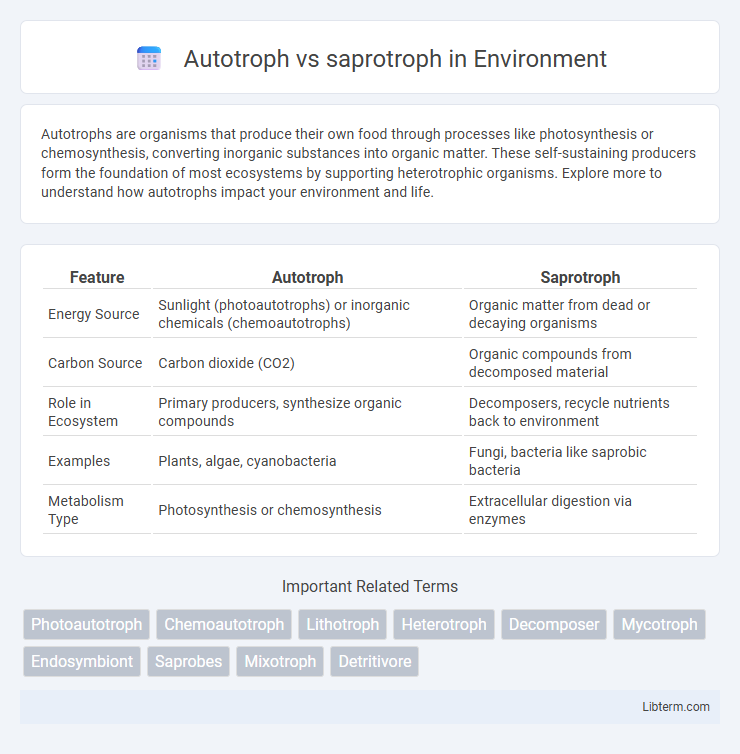Autotrophs are organisms that produce their own food through processes like photosynthesis or chemosynthesis, converting inorganic substances into organic matter. These self-sustaining producers form the foundation of most ecosystems by supporting heterotrophic organisms. Explore more to understand how autotrophs impact your environment and life.
Table of Comparison
| Feature | Autotroph | Saprotroph |
|---|---|---|
| Energy Source | Sunlight (photoautotrophs) or inorganic chemicals (chemoautotrophs) | Organic matter from dead or decaying organisms |
| Carbon Source | Carbon dioxide (CO2) | Organic compounds from decomposed material |
| Role in Ecosystem | Primary producers, synthesize organic compounds | Decomposers, recycle nutrients back to environment |
| Examples | Plants, algae, cyanobacteria | Fungi, bacteria like saprobic bacteria |
| Metabolism Type | Photosynthesis or chemosynthesis | Extracellular digestion via enzymes |
Introduction to Autotrophs and Saprotrophs
Autotrophs are organisms that produce their own food by converting inorganic substances into organic material through processes like photosynthesis or chemosynthesis. Saprotrophs obtain nutrition by decomposing dead organic matter, playing a crucial role in nutrient recycling within ecosystems. The fundamental difference lies in autotrophs synthesizing food internally, while saprotrophs externally digest and absorb nutrients from decaying matter.
Definition of Autotrophs
Autotrophs are organisms capable of synthesizing their own food from inorganic substances using light or chemical energy, primarily through photosynthesis or chemosynthesis. Unlike saprotrophs, which obtain nutrients by decomposing dead organic matter, autotrophs serve as primary producers in ecosystems. Examples include plants, algae, and certain bacteria that convert carbon dioxide and water into glucose and oxygen.
Definition of Saprotrophs
Saprotrophs are organisms that obtain nutrients by decomposing dead organic matter, playing a crucial role in nutrient cycling within ecosystems. Unlike autotrophs, which produce their own food through photosynthesis or chemosynthesis, saprotrophs rely on external organic substances for energy. Fungi and certain bacteria are prime examples of saprotrophs, breaking down complex organic materials into simpler compounds accessible to other life forms.
Key Differences Between Autotrophs and Saprotrophs
Autotrophs synthesize their own food using light or chemical energy through photosynthesis or chemosynthesis, serving as primary producers in ecosystems. Saprotrophs obtain nutrients by decomposing dead organic matter, relying on external organic sources for energy. The key difference lies in autotrophs' ability to produce organic compounds from inorganic substances, whereas saprotrophs depend on consuming and breaking down pre-existing organic material.
Types of Autotrophs
Autotrophs are classified mainly into photoautotrophs and chemoautotrophs, based on their energy sources; photoautotrophs, such as plants, algae, and cyanobacteria, utilize sunlight to perform photosynthesis, converting carbon dioxide and water into organic compounds. Chemoautotrophs, including certain bacteria like nitrifying bacteria and sulfur-oxidizing bacteria, obtain energy by oxidizing inorganic substances like ammonia or hydrogen sulfide, enabling them to thrive in environments devoid of sunlight. These distinctions highlight the diverse mechanisms autotrophs employ to sustain the base of ecosystems and support heterotrophic organisms.
Types of Saprotrophs
Saprotrophs are primarily classified into fungi and bacteria, both playing critical roles in decomposing organic matter and recycling nutrients in ecosystems. Fungal saprotrophs, such as mushrooms and molds, excel in breaking down complex plant materials like cellulose and lignin, while bacterial saprotrophs typically decompose simpler compounds and contribute to soil fertility. Unlike autotrophs that produce their own food through photosynthesis or chemosynthesis, saprotrophs rely on external organic matter for energy, making them essential for nutrient cycling and ecosystem sustainability.
Nutritional Strategies of Autotrophs
Autotrophs use photosynthesis or chemosynthesis to convert inorganic substances like carbon dioxide and sunlight or chemical energy into organic matter, forming the base of most ecosystems. They synthesize their own food, making them primary producers in food chains, unlike saprotrophs that obtain nutrients by decomposing dead organic material. This nutritional strategy enables autotrophs to sustain energy flow and support heterotrophic organisms in diverse habitats.
Role of Saprotrophs in Ecosystems
Saprotrophs play a crucial role in ecosystems by decomposing dead organic matter and recycling nutrients back into the soil, which supports plant growth and maintains soil fertility. Unlike autotrophs that produce their own food through photosynthesis or chemosynthesis, saprotrophs obtain energy by breaking down complex organic compounds from dead organisms. This decomposition process facilitates nutrient cycling, sustaining ecosystem productivity and biodiversity.
Importance of Autotrophs in Food Chains
Autotrophs, such as plants and algae, serve as primary producers in food chains by converting sunlight into chemical energy through photosynthesis, forming the base of almost all ecosystems. Saprotrophs, including fungi and bacteria, play a crucial role in decomposition by breaking down dead organic matter and recycling nutrients back into the soil. The energy flow initiated by autotrophs sustains herbivores and higher trophic levels, making them indispensable for ecosystem stability and energy transfer.
Ecological Impact: Autotrophs vs Saprotrophs
Autotrophs, such as plants and algae, play a crucial role in ecosystems by converting carbon dioxide into organic matter through photosynthesis, forming the base of most food chains and contributing to oxygen production. Saprotrophs, including fungi and bacteria, decompose dead organic material, recycling nutrients like nitrogen and phosphorus back into the soil, which supports plant growth and maintains soil fertility. Together, autotrophs and saprotrophs sustain ecosystem productivity and nutrient cycling essential for ecological balance.
Autotroph Infographic

 libterm.com
libterm.com